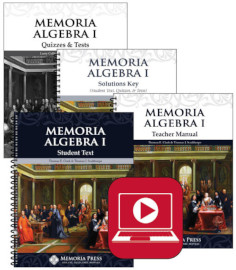Memoria Algebra I teaches algebra in a classical manner, suitable for students whether or not they want to pursue STEM fields in college. It is very logical in its presentation and builds concepts progressively step-by-step. This course is the second of three in Memoria Press’s algebra series, which begins with Memoria Pre-Algebra and concludes with Memoria Algebra II (not yet available).
In preparation for this course, students should have learned algebraic symbols and terms, how to solve first-degree equations and inequalities with one variable, and how to graph those equations. A readiness exam is in the Teacher Manual.
Memoria Algebra I teaches “first-degree relations with two variables, first-degree relations with three or more variables, higher degree relations with polynomials and algebraic fractions, and rational degree relations.”
The course is presented in five units, three to six parts per unit, and two to ten lessons per part, for a total of 92 lessons plus quizzes and exams. An introductory page at the beginning of each unit and each part explains the overarching goals and provides interesting information on the history of mathematics and famous mathematicians.
Course components are the Student Text, Teacher Manual, Solutions Key, Quizzes & Tests book, and online videos. (The Student Text, Teacher Manual, and Solutions Key have a spiral binding so they lie flat when open.) In addition, when you order the course, you receive a link to download a PDF of the Quizzes & Tests book so you can print as many copies as you need.
How It Works
The first unit begins with first-degree relations with two variables and has students identify sets of ordered points on a Cartesian grid that satisfy one equation whose solutions can be drawn as a line. It then moves to systems of two equations with two variables for which the solution is only one ordered pair (a point). Then it shifts to inequalities where boundary lines identify infinite sets of solutions and non-solutions. Using the Cartesian coordinate system to visually show results gives students a strong visual understanding of algebraic concepts. The rest of the course continues to build concepts with additional complexity in this same fashion.
Word problems are incorporated into each unit, including motion problems that use the equation distance = rate x time, geometric problems [e.g., “The perimeter of a square is four units more than its area. Find the length of a side” (p. 190)], and mixed variation problems such as,
The simple interest (I) earned by a savings deposit in a given time varies jointly as the principal (P) and the interest rate (r). If the interest is $180 when the principal is $1000 and the rate is 0.06, find the interest for the same amount of time when the principal is $750 and the rate is still 0.06 (p. 238).
The course is designed to be presented by a teacher. Lesson notes in the Teacher Manual can be used by an inexperienced teacher (with advance preparation) or students can watch the instructional videos (online) by course co-author Thomas Sculthorpe. The notes in the Teacher Manual are similar to Sculthorpe’s teaching, so you can use either the videos or teach it yourself—not both unless students need a second presentation.
There’s plenty of help for students who get stuck. Lessons in the Student Text have worked out examples. An answer key for odd-numbered problems is at the back of the Student Text, so they can somewhat check themselves as they work. The Teacher Manual has answers to exercises, and the Solutions Key has worked out answers for all exercises, quizzes, and tests.
The number of questions in exercises varies according to their complexity. There might be 10 problems in an exercise set that requires solving problems and graphing solutions and more than 20 problems in a set that requires less work per problem. Students will need graph paper for drawing Cartesian grids, and using graph paper for all problem-solving should help students align their work neatly.
In addition, students need to master the 96 definitions, properties, and formulas listed at the back of both the Student Text and the Teacher Manual. The Teacher Manual suggests frequent recitation of both new and previously learned recitation facts. However, in the videos, Sculthorpe tells students to memorize them but doesn’t have them recite them in class. So a teacher or supervisor might incorporate recitation into the teaching portion of the lesson or they might rely on students to memorize them on their own.
Each part of a unit has a quiz (21 quizzes in all), every unit has a test, and there is a final exam. All quizzes and tests have both a Form A and Form B that can be used for retaking them or as review assignments.
As I said in my review of the Memoria Pre-Algebra course, the logical design, the inclusion of conceptual thinking, and the memorization of the recitation questions all make this course particularly appealing to those pursuing a classical form of education, but it isn’t limited to that audience.
Summary
Memoria Algebra I requires logical and systematic thinking skills. While it is a challenging course, diligent students should do well with it.









